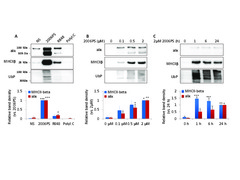Blar i forfatter "Strandskog, Guro"
-
Composition of exosomes derived from Atlantic salmon (Salmo salar) head kidney leukocytes
Strandskog, Guro; Sobhkhez, Mehrdad; Jørgensen, Jorunn B; Iliev, Dimitar Borisov (Conference object; Konferansebidrag, 2015-06-28)Exosomes are secreted nanosize vesicles (30−100 nm) derived from multivesicular endosomes. Exosomes are released by different immune cell types, including T- and B-lymphocytes, mast cells and antigen-presenting cells (APCs). The composition of exosomes - including protein and RNA content reflects their endosomal origin and the type of cells that produce them. Mammalian APCs produce large amounts ... -
Differences in smolt status affect the resistance of Atlantic salmon (Salmo salar L.) against infectious pancreatic necrosis, while vaccine-mediated protection is unaffected
Jensen, Ingvill; Overrein, Mathias; Fredriksen, Børge Nilsen; Strandskog, Guro; Seternes, Tore (Journal article; Tidsskriftartikkel; Peer reviewed, 2019-06-18)In today's aquaculture of Atlantic salmon (<i>Salmo salar</i> L.), a majority of viral disease outbreaks occur after seawater transfer. A relevant question is how the parr–smolt transformation influences the efficacy of viral vaccines and the innate resistance against viral diseases. In this study, vaccinated and unvaccinated A. salmon parr were exposed to different photoperiodic regimens (1‐, 3‐ ... -
Intramuscular vaccination of Atlantic lumpfish (Cyclopterus lumpus L.) induces inflammatory reactions and local immunoglobulin M production at the vaccine administration site
Erkinharju, Toni; Strandskog, Guro; Vågnes, Øyvind; Hordvik, Ivar; Dalmo, Roy Ambli; Seternes, Tore (Journal article; Tidsskriftartikkel; Peer reviewed, 2019-10-20)Atlantic lumpfish were vaccinated by intramuscular (im) or intraperitoneal (ip) injection with a multivalent oil‐based vaccine, while control fish were injected with phosphate‐buffered saline. Four lumpfish per group were sampled for skin/muscle and head kidney tissue at 0, 2, 7, 21 and 42 days post‐immunization (dpi) for histopathology and immunohistochemistry (IHC). Gene expressions of secretory ... -
Salmonid Alphavirus Subtype 3 Induces Prolonged Local B Cell Responses in Atlantic Salmon (Salmo salar) After Intraperitoneal Infection
Jenberie, Shiferaw; Penaranda, Ma Michelle Demogina; Thim, Hanna Leena; Styrvold, Morten Bay; Strandskog, Guro; Jørgensen, Jorunn B; Jensen, Ingvill (Journal article; Tidsskriftartikkel; Peer reviewed, 2020-09-10)B cell responses are a crucial part of the adaptive immune response to viral infection. Infection by salmonid alphavirus subtype 3 (SAV3) causes pancreas disease (PD) in Atlantic salmon (<i>Salmo salar</i>) and is a serious concern to the aquaculture industry. In this study, we have used intraperitoneal (IP) infection with SAV3 as a model to characterize local B cell responses in the peritoneal ... -
Secretome Profiling of Atlantic Salmon Head Kidney Leukocytes Highlights the Role of Phagocytes in the Immune Response to Soluble β-Glucan
Iliev, Dimitar B.; Strandskog, Guro; Sobhkhez, Mehrdad; Bruun, Jack A.; Jørgensen, Jorunn B. (Journal article; Tidsskriftartikkel; Peer reviewed, 2021-11-30)b‐Glucans (BG) are glucose polymers which are produced in bacteria and fungi but not in vertebrate organisms. Being recognized by phagocytic leukocytes including macrophages and neutrophils through receptors such as dectin-1 and Complement receptor 3 (CR3), the BG are perceived by the innate immune system of vertebrates as foreign substances known as Pathogen Associated Molecular Patterns (PAMPs). ... -
Stimulation of exosome release by extracellular DNA is conserved across multiple cell types
Iliev, Dimitar Borisov; Strandskog, Guro; Nepal, Arpita; Aspar, Augusta; Olsen, Randi; Jørgensen, Jorunn B; Wolfson, Deanna; Ahluwalia, Balpreet Singh; Handzhiyski, Jordan; Mironova, Roumyana (Journal article; Tidsskriftartikkel; Manuskript; Peer reviewed; Preprint, 2018-06-28)Exosomes are distinguished from other types of extracellular vesicles by their small and relatively uniform size (30-100 nm) and their composition which reflects their endo-lysosomal origin. Involvement of these extracellular organelles in intercellular communication and their implication in pathological conditions has fuelled intensive research on mammalian exosomes; however, currently, very little ...


 English
English norsk
norsk




